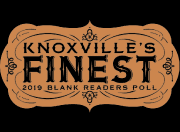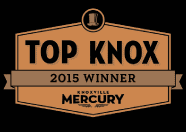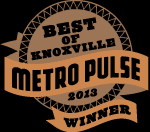
In the post-Big Ears afterglow, it’s time to reflect. Referencing many of our experiences as “a journey” rings almost hollow from overuse. Life, career, marriage, prolonged illness, and sometimes literal travel all give way to the construct. I repeatedly heard the metaphor used in reference to Big Ears. It’s a journey through a sometimes unfamiliar soundscape.
And each person’s journey can never be the same as we bring different understandings, preferences, and even emotions to the festival. I found it repeatedly remarkable to converse with friends with whom I share overlapping musical tastes as we chose entirely different pathways through the festival. As of this writing, I haven’t read Leslie’s first installment, but I suspect we barely overlapped. We got our credentials and never saw each other again. Different journeys.
Lots of strategic choices must be made by the careful planners (in advance) or the wanderers (in the moment). How far do I want to walk or how much time do I want devote to walking. Is the artist in the distant venue worth missing two other shows for the walk? And which venues do I prefer? Is it all about the music I love or do I want to be more adventurous. My favorite artists or others who are new to me? Will I stop to eat or drink? Lots of hard calls.
I’m more a planner who is willing to jettison plans if real-time developments (like hunger, running into friends, or rumors about a cool thing I didn’t see coming) warrant doing so. I also really try to avoid drive-bys (seeing only a few minutes of a show), trying to give at least a half-hour to a show and making as many full shows as possible. In the end, I made it to 23 performances walking about 50,000 steps in four days.
I also saw more movies than I’ve ever seen at Big Ears. I generally miss great movies in preference for live music that I may never have a chance to see again. Turns out, this year’s festival was chock-full of movies I may never have the chance to see again and they were fabulous. I also took in three art exhibitions.

My Big Ears began with a special show on Wednesday night at the Knoxville Museum of Art. New music by the great Donald Brown, inspired by his exploration of the letters of Beauford Delany, filled the Grand Hall delivered at the hands of many of Knoxville’s finest musicians. Urban Girl got her first taste of Big Ears at the free event and I took her through the excellent Higher Ground exhibition of the works of Beauford and Joseph Delaney. The music was great, but the highlight had to be seeing Donald stand behind a keyboard once more after a long battle to make it happen as he’s faced serious physical struggles.

The next afternoon, I hit a couple of art galleries, including the stunning and complex work of Pangrok Sulap, a Malaysian collective from Borneo. The work flows with detail, overwhelms with complexity, and offers tiny new revelations as long as you’d want to look. The work was presented in RED Gallery by UT College of Arts and Sciences, the UT School of Art, the UT Department of English and the Denbo Center for Humanities & the Arts. I also watched a bit of Kite Symphony at the UT Downtown Gallery and I’d already checked out the Violins of Hope, also on the 100 Block. It’s still there and must be seen.
And then I started my cinematic journey with Gadjo Dilo (1997), followed by Nosotros, la Musica (1964). The former is a narrative movie mostly in French and Romani with subtitles. Focused on the culture and music of the Romani people, it offered a glimpse of both. The later features footage shot in pre-Castro Cuba with a focus on the music. Not so much a documentary, the film served up a montage of music from the era. Music that was soon to be repressed by the Castro regime.
To complete the film sequence, on Friday I started my day with The Harder They Come (1972), the reggae classic I’d never had a chance to see on the big screen. I followed that with the brilliant Jimi Hendrix (1973), which had a major release that year, but has been out of circulation now for many years and isn’t available to stream. Sunday morning I went to church with Aretha Franklin in the form of her brilliant concert (actually back-to-back nights) in 1972 at the New Temple Missionary Baptist Church in Los Angeles. The record from those shows sold two million copies. The footage didn’t get released until 2018 due to the inability to sync the sound with the footage until the film wound up in the right hands and modern technology accomplished what was impossible in 1972.
And those were just the movies I managed to see. Others I would have loved to have seen simply did not fit my schedule. This is the first year Big Ears sold a movies-only pass and I’d highly recommend it if you don’t want to do the entire festival. Lily Keber masterminded the whole thing and a residency by legendary producer and author Joe Boyd anchored the whole thing. Joe, who was the force behind getting both the Aretha and Hendrix films made, attended and spoke.
Oh yeah, I also head some music.

Thursday evening I attended the first half of The Mockingbird by R.B. Morris and Wil Wright at Saint John’s Cathedral. R.B. read from his book of poetry of the same name as another crew of some of Knoxville’s finest musicians played a score by Wright. Other than the boomy sound in the room, it offered up a great start to the festival with a taste of local. I managed to stay for about half the show before running over to the Bijou.

Charles Lloyd became a favorite of mine two years ago when I heard his set at Big Ears and I’ve not been able to pass up a performance since. He’s a crazy great saxophonist who takes occasional breaks to be great on piano or flute. He’s a master of jazz, but restless enough to spice up his music by joining with a range of other masters and dancing all over any genre labels. Sadly, this night was dedicated to his collaborator of the last twenty years, Zakir Hussain, who died just three months ago. Lloyd was joined by Eric Harland (both of whom were scheduled to play the show with Hussain), guitarist Bill Frisell, Harish Raghaan, and brilliant vocalist Ganavya. Intended as an uplifting memorial, the music soared.

Continuing my jazz journey for the night, Axiom 5 had the crowd at the Bijou grooving through their entire set. Anchored by master drummer Barry Altschul, he was joined by John Irabagon (saxophone), Uri Caine (piano), and Mark Helias (bass). With back-to-back full shows, I walked to the Mill and Mine knowing I might not make it through.

Darkside, comprised of a trio featuring a member on electronica (Nicolás Jaar, a multi-instrumentalist (Dave Harrington), and a drummer (Tiacael Esparza), stormed their way onto the stage in a wild foggy mist which all but completely obscured them from the audience. Aggressive out the gate, the band launched into their electronic jam-band tour-de-force and electrified the crowd. Not so great for photographers, of course, but we weren’t the point. I enjoyed about a half hour before heading home at midnight.

My Friday started with the aforementioned brilliant movies The Harder They Come and Jimi Hendrix at the Regal Riviera Cinema before taking the trek to the Point. It was my first of two trips to the Magnolia Avenue venue. A great showcase for artists who lean toward the quieter side, this show featured Cassandra Jenkins with her folk/indie music and observational, though personal, songs. Quite hypnotic.

With that, I walked to the opposite end of the Big Ears footprint to hear the Sun Ra Arkestra with Yo La Tengo at the Civic Auditorium. We started off with a trip to Mars and then bounced between the two catalogs of quite different music that seemed to blend as if it belonged together. I enjoyed hearing the Arkestra playing a differnt kind of music as they joined the indie trio. Conversely, Yo La Tengo fit right in and seemed to enjoy their ventures into outer space.



Three dynamite artists ended my night. After a brief break, I found my way back to the Civic Auditorium for Esperanza Spalding. There might be a cuter, more creative, more talented, smarter, wittier person somewhere out in the universe, but I doubt it. The performance, rooted in jazz vocals, but covering lots of sonic territory charmed the capacity crowd. And shout out to the dancers who added so much and the light person for making spectacular visuals and allowing photographers everywhere to celebrate. The entire show felt pitch perfect.

My jazz-heavy ventures continued with Steve Coleman and Five Elements. Coleman started his musical life with the violin, but soon found the saxophone. His primary musical vehicle, the band Five Elements, has been together since 1981. They look like the guys down the street playing the local hole-in-the-wall, but they sound like the masters of jazz, served up with a side of funk, that they are. One the best shows I saw.

I ended my Friday night with an old friend, Taj Mahal, at the Tennessee Theatre. He may not move like he used to. His voice may be a register or so lower than it used to be. But there was the man in all his glory. He leaned heavily on the classics from his long career, including the songs I came to love on the radio in the early days of FM where he was played alongside Jimi Hendrix, Emmylou Harris, and Led Zeppelin. Just great music. And a delightful man. I Cakewalked all the way across the street to my bed.



























































































Recent Comments